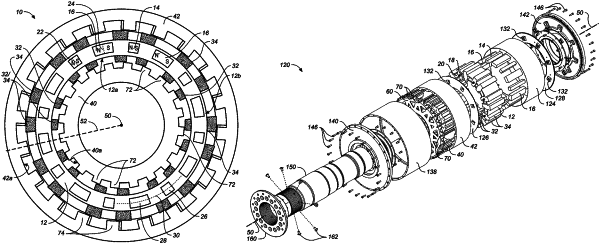| CPC H02K 55/02 (2013.01) [H02K 1/24 (2013.01); H02K 16/02 (2013.01); H02K 21/44 (2013.01); H10N 60/20 (2023.02)] | 23 Claims |

|
1. A dual pole parallel path switched reluctance motor, comprising:
an annular dual pole stator disposed in a stationary position about a central axis, said stator having a core and paired opposing inner and outer salient stator poles each having windings to form stator coils, said inner salient stator poles disposed on an inner annular side of said stator core and extending toward said central axis, said outer salient stator poles disposed on an outer annular side of said stator core and extending away from said central axis;
an inner annular salient pole rotor concentrically disposed said central axis in a magnetically coupled relationship to said stator with evenly spaced salient poles on an outer side extending away from said central axis and toward said stator;
an outer annular salient pole rotor concentrically disposed said central axis in a magnetically coupled relationship to said stator with evenly spaced salient poles on an inner side extending toward said central axis and said stator;
a mechanical coupler disposed between and connecting said inner and outer annular salient pole rotors and synchronizing their rotation to apply their torque in combination when operated; and
a plurality of magnets disposed in said stator;
wherein said permanent magnets and said inner and outer salient stator poles form a pole group, such that when said stator poles are energized, the polarity of paired inner and outer stator poles is oriented in the same direction and is the opposite of the polarity of any adjacent paired inner and outer stator poles, and a magnetic flux is induced that redirects and complements the ambient permanent magnetic flux to create a closed and continuous short flux path to drive said rotors.
|